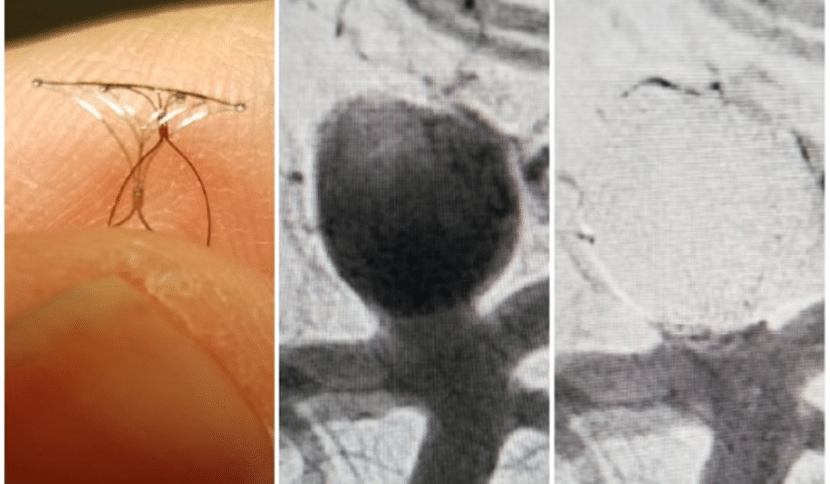Basilar tip aneurysms have a reputation for being hard to treat. When an Austin-area patient recently presented with this type of aneurysm, one of ARA Diagnostic Imaging’s neurointerventional surgeons, Dr. Kirk Conrad, was able to treat her condition with an advanced device called PulseRider, positioning ARA as the first group in Austin to place the device in a patient.
PulseRider, by Cerenovus, was specifically designed to help seal off basilar tip aneurysms, which are broad-necked aneurysms that arise on or near the bifurcation of an artery, where it splits into two smaller blood vessels. PulseRider marks an improvement in the ability to treat basilar tip aneurysms and offers an alternative to the conventional stent that is sometimes used in endovascular treatment of brain aneurysms. Most importantly, the PulseRider device will greatly enhance treatment of patients that develop this condition.
PulseRider device, basilar tip aneurysm before and after treatment
The U.S. Food and Drug Administration (FDA) recently approved PulseRider under the Humanitarian Device Exemption—a regulatory pathway for medical devices intended to treat rare disorders or conditions.
Dr. Conrad’s patient, the first Austin-area patient to receive the PulseRider device, did well during the procedure and has continued to respond positively, reporting no problems on her first follow up.
Brain aneurysms form when a weak spot in the wall of a blood vessel balloons out and fills with blood. They can rupture at any time and cause bleeding into the brain, which can result in death or strokes. About 30,000 people in the United States suffer a brain aneurysm rupture each year. 1 Ruptures can cause nearly instant death and are likely to leave those that survive the initial rupture with significant disability.
If an aneurysm is caught before rupturing, it can sometimes be treated with endovascular coiling. This procedure is done by inserting a hollow plastic catheter into an artery, guiding it to the aneurysm, and then pushing soft platinum wire through the catheter and into the aneurysm, where it coils up and seals it off, preventing rupture. The PulseRider’s Y or T shape, when placed at branching areas of arteries in the brain where a basilar tip aneurysm has formed, provides support for the placement of coils that fill the aneurysm cavity and block it off of the artery, preventing rupture. Using materials available previous to PulseRider, this intervention was very challenging and not as successful in treating the patient.
PulseRider device and three possible placements in a basilar tip aneurysm
ARA has a long history of leading central Texas in endovascular surgery. Among ARA firsts are the first coiling of a brain aneurysm, first endovascular treatment for stroke, first carotid stent and intracranial stents, first glue embolization of arteriovenous malformation (AVM), first repair of carotid cavernous fistula (CCF) and many others.
Before his first procedure with PulseRider, Dr. Conrad underwent special training in which he deployed the device in a flow model in a laboratory setting. He did his neurointerventional surgery fellowship at Massachusetts General Hospital, Harvard Medical School.
Always pursuing the best technology for our patients, ARA Diagnostic Imaging is pleased to add PulseRider to our toolkit for the treatment of aneurysms.
References
- Brain Aneurysm Foundation. “Statistics and Facts.” www.bafound.org/about-brain-aneurysms/brain-aneurysm-basics/. Accessed July 8, 2019.
